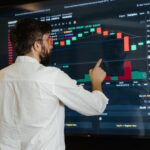Leverage is a crucial concept in forex trading. In fact, though a few of the most cautious traders only rely on their own cash reserves, the vast majority will use some kind of leverage to increase their profit potential. But what is leverage, exactly, and what is the best way to maximize this without taking undue risks?
Doing more with less
In simple trading terms, leverage refers to the act of using borrowed money in order to be able to make a larger stake in a trade. Imagine, for example, that someone uses €100 to purchase $110. Over the course of the next month, the value of the dollar increases until it achieves parity with the euro. This means the trader can then sell the $110 for €110, making €10 of pure profit — not bad, but certainly not too significant, either.
Yet, if they had leveraged their capital by borrowing from the broker at a ratio of 1:10, they could have purchased $1,000 and made €100 but only invested €100. In effect, they could have doubled their money (minus the broker’s fee, of course). With a ratio of 1:100, the return would be €1,000 on that same €100 investment. In other words, leverage enables traders to take big positions with small capital and magnify profits in proportion to their leverage.
Reducing risk and exposure
The potential for greater rewards, of course, also brings greater risk. So how can traders manage their exposure to losses? Initially, it is advisable to trade with smaller amounts and make trades with a more modest leverage ratio. It is also a good idea to primarily trade with less volatile markets in the beginning. In time, once the trader is happy studying forex charts all hours of the day and has mastered the market fundamentals, they will have the confidence to take bigger risks.
Even then, however, it is essential to employ some measures to ensure any losses do not grow too big. Position sizing — picking out the suitable position size in relation to risk endurance and prospective rewards — is a crucial analytical tool. Similarly, using stop-loss orders, where the trade is automatically terminated at a predefined price point, can help ensure losses never spiral out of control.
Mixing it up
Most forex traders also ensure a significant level of diversification. This can entail both distributing investments across various currency pairs and markets, and making investments in other areas, such as the stock market or bonds. In each case, the goal is to minimize the influence of an individual trade or market event on the overall investment portfolio.
The good news is that employing these kinds of steps actually makes it easier to take risks. These safeguards are in place to ensure that, as the old adage goes, you are only risking what you can afford to lose. Forex trading can be a successful endeavor, but it is also always much more effective and rewarding in the long term if one maintains the right balance between risk and reward.







